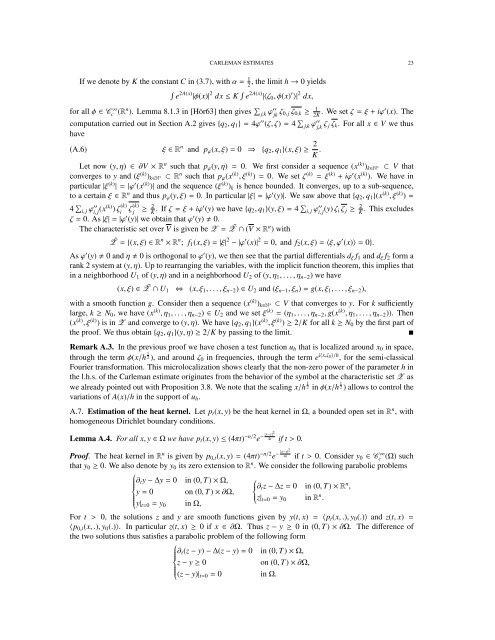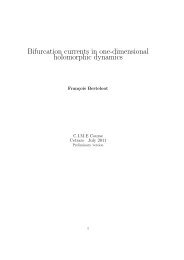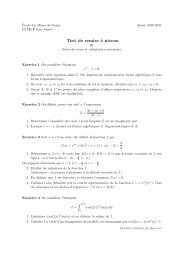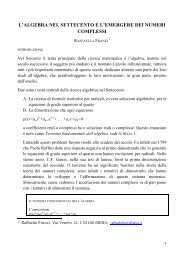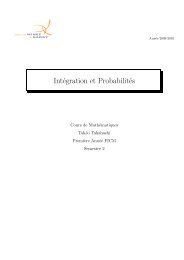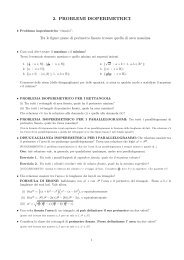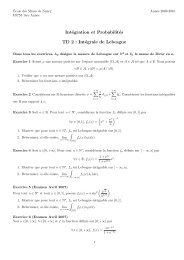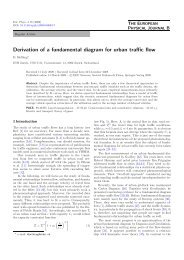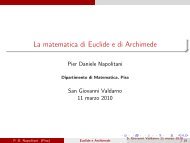on carleman estimates for elliptic and parabolic operators ...
on carleman estimates for elliptic and parabolic operators ...
on carleman estimates for elliptic and parabolic operators ...
Create successful ePaper yourself
Turn your PDF publications into a flip-book with our unique Google optimized e-Paper software.
CARLEMAN ESTIMATES 23<br />
If we denote by K the c<strong>on</strong>stant C in (3.7), with α = 1 2<br />
, the limit h → 0 yields<br />
∫ e 2A(x) |φ(x)| 2 dx ≤ K ∫ e 2A(x) |〈ζ 0 , φ(x) ′ 〉| 2 dx,<br />
<strong>for</strong> all φ ∈ Cc ∞ (R n ). Lemma 8.1.3 in [Hör63] then gives ∑ j,k ϕ ′′<br />
jk ζ 0, j ζ 0,k ≥ 1<br />
2K . We set ζ = ξ + iϕ′ (x). The<br />
computati<strong>on</strong> carried out in Secti<strong>on</strong> A.2 gives {q 2 , q 1 } = 4ϕ ′′ (ζ, ζ) = 4 ∑ j,k ϕ ′′<br />
j,k ζ j ζ k . For all x ∈ V we thus<br />
have<br />
(A.6)<br />
ξ ∈ R n <strong>and</strong> p ϕ (x, ξ) = 0 ⇒ {q 2 , q 1 }(x, ξ) ≥ 2 K .<br />
Let now (y, η) ∈ ∂V × R n such that p ϕ (y, η) = 0. We first c<strong>on</strong>sider a sequence (x (k) ) k∈N ∗ ⊂ V that<br />
c<strong>on</strong>verges to y <strong>and</strong> (ξ (k) ) k∈N ∗ ⊂ R n such that p ϕ (x (k) , ξ (k) ) = 0. We set ζ (k) = ξ (k) + iϕ ′ (x (k) ). We have in<br />
particular |ξ (k) | = |ϕ ′ (x (k) )| <strong>and</strong> the sequence (ξ (k) ) k is hence bounded. It c<strong>on</strong>verges, up to a sub-sequence,<br />
to a certain ξ ∈ R n <strong>and</strong> thus p ϕ (y, ξ) = 0. In particular |ξ| = |ϕ ′ (y)|. We saw above that {q 2 , q 1 }(x (k) , ξ (k) ) =<br />
ζ (k)<br />
j<br />
≥ 2 K . If ζ = ξ + iϕ′ (y) we have {q 2 , q 1 }(y, ξ) = 4 ∑ i, j ϕ ′′<br />
i, j (y) ζ i ζ j ≥ 2 K<br />
. This excludes<br />
4 ∑ i, j ϕ ′′<br />
i, j (x(k) ) ζ (k)<br />
i<br />
ζ = 0. As |ξ| = |ϕ ′ (y)| we obtain that ϕ ′ (y) 0.<br />
The characteristic set over V is given be Z =<br />
˜ Z ∩ (V × R n ) with<br />
˜ Z = {(x, ξ) ∈ R n × R n ; f 1 (x, ξ) = |ξ| 2 − |ϕ ′ (x)| 2 = 0, <strong>and</strong> f 2 (x, ξ) = 〈ξ, ϕ ′ (x)〉 = 0}.<br />
As ϕ ′ (y) 0 <strong>and</strong> η 0 is orthog<strong>on</strong>al to ϕ ′ (y), we then see that the partial differentials d ξ f 1 <strong>and</strong> d ξ f 2 <strong>for</strong>m a<br />
rank 2 system at (y, η). Up to rearranging the variables, with the implicit functi<strong>on</strong> theorem, this implies that<br />
in a neighborhood U 1 of (y, η) <strong>and</strong> in a neighborhood U 2 of (y, η 1 , . . . , η n−2 ) we have<br />
(x, ξ) ∈ Z˜<br />
∩ U 1 ⇔ (x, ξ 1 , . . . , ξ n−2 ) ∈ U 2 <strong>and</strong> (ξ n−1 , ξ n ) = g(x, ξ 1 , . . . , ξ n−2 ),<br />
with a smooth functi<strong>on</strong> g. C<strong>on</strong>sider then a sequence (x (k) ) k∈N ∗ ⊂ V that c<strong>on</strong>verges to y. For k sufficiently<br />
large, k ≥ N 0 , we have (x (k) , η 1 , . . . , η n−2 ) ∈ U 2 <strong>and</strong> we set ξ (k) = (η 1 , . . . , η n−2 , g(x (k) , η 1 , . . . , η n−2 )). Then<br />
(x (k) , ξ (k) ) is in Z <strong>and</strong> c<strong>on</strong>verge to (y, η). We have {q 2 , q 1 }(x (k) , ξ (k) ) ≥ 2/K <strong>for</strong> all k ≥ N 0 by the first part of<br />
the proof. We thus obtain {q 2 , q 1 }(y, η) ≥ 2/K by passing to the limit.<br />
<br />
Remark A.3. In the previous proof we have chosen a test functi<strong>on</strong> u h that is localized around x 0 in space,<br />
through the term φ(x/h 1 2 ), <strong>and</strong> around ζ 0 in frequencies, through the term e i〈x,ζ0〉/h , <strong>for</strong> the semi-classical<br />
Fourier trans<strong>for</strong>mati<strong>on</strong>. This microlocalizati<strong>on</strong> shows clearly that the n<strong>on</strong>-zero power of the parameter h in<br />
the l.h.s. of the Carleman estimate originates from the behavior of the symbol at the characteristic set Z as<br />
we already pointed out with Propositi<strong>on</strong> 3.8. We note that the scaling x/h 1 2 in φ(x/h 1 2 ) allows to c<strong>on</strong>trol the<br />
variati<strong>on</strong>s of A(x)/h in the support of u h .<br />
A.7. Estimati<strong>on</strong> of the heat kernel. Let p t (x, y) be the heat kernel in Ω, a bounded open set in R n , with<br />
homogeneous Dirichlet boundary c<strong>on</strong>diti<strong>on</strong>s.<br />
Lemma A.4. For all x, y ∈ Ω we have p t (x, y) ≤ (4πt) −n/2 e − |x−y|2<br />
4t if t > 0.<br />
Proof. The heat kernel in R n is given by p 0,t (x, y) = (4πt) −n/2 e − |x−y|2<br />
4t if t > 0. C<strong>on</strong>sider y 0 ∈ Cc ∞ (Ω) such<br />
that y 0 ≥ 0. We also denote by y 0 its zero extensi<strong>on</strong> to R n . We c<strong>on</strong>sider the following <strong>parabolic</strong> problems<br />
⎧<br />
∂ t y − ∆y = 0 in (0, T) × Ω, ⎧<br />
⎪⎨<br />
⎪⎨ ∂ t z − ∆z = 0 in (0, T) × R n ,<br />
y = 0 <strong>on</strong> (0, T) × ∂Ω, ⎪⎩ z| ⎪⎩<br />
t=0 = y 0 in R n .<br />
y| t=0 = y 0 in Ω,<br />
For t > 0, the soluti<strong>on</strong>s z <strong>and</strong> y are smooth functi<strong>on</strong>s given by y(t, x) = 〈p t (x, .), y 0 (.)〉 <strong>and</strong> z(t, x) =<br />
〈p 0,t (x, .), y 0 (.)〉. In particular z(t, x) ≥ 0 if x ∈ ∂Ω. Thus z − y ≥ 0 in (0, T) × ∂Ω. The difference of<br />
the two soluti<strong>on</strong>s thus satisfies a <strong>parabolic</strong> problem of the following <strong>for</strong>m<br />
⎧<br />
∂ t (z − y) − ∆(z − y) = 0 in (0, T) × Ω,<br />
⎪⎨<br />
z − y ≥ 0<br />
<strong>on</strong> (0, T) × ∂Ω,<br />
⎪⎩ (z − y)| t=0 = 0 in Ω.


